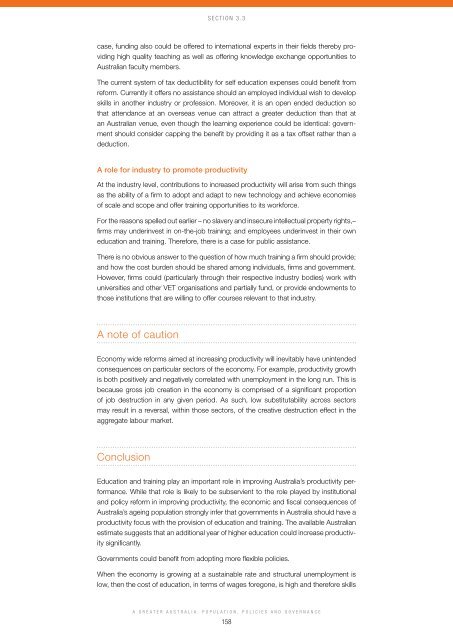A Greater Australia: Population, policies and governance - CEDA
A Greater Australia: Population, policies and governance - CEDA
A Greater Australia: Population, policies and governance - CEDA
- No tags were found...
Create successful ePaper yourself
Turn your PDF publications into a flip-book with our unique Google optimized e-Paper software.
Section 3.3case, funding also could be offered to international experts in their fields thereby providinghigh quality teaching as well as offering knowledge exchange opportunities to<strong>Australia</strong>n faculty members.The current system of tax deductibility for self education expenses could benefit fromreform. Currently it offers no assistance should an employed individual wish to developskills in another industry or profession. Moreover, it is an open ended deduction sothat attendance at an overseas venue can attract a greater deduction than that atan <strong>Australia</strong>n venue, even though the learning experience could be identical: governmentshould consider capping the benefit by providing it as a tax offset rather than adeduction.A role for industry to promote productivityAt the industry level, contributions to increased productivity will arise from such thingsas the ability of a firm to adopt <strong>and</strong> adapt to new technology <strong>and</strong> achieve economiesof scale <strong>and</strong> scope <strong>and</strong> offer training opportunities to its workforce.For the reasons spelled out earlier – no slavery <strong>and</strong> insecure intellectual property rights,–firms may underinvest in on-the-job training; <strong>and</strong> employees underinvest in their owneducation <strong>and</strong> training. Therefore, there is a case for public assistance.There is no obvious answer to the question of how much training a firm should provide;<strong>and</strong> how the cost burden should be shared among individuals, firms <strong>and</strong> government.However, firms could (particularly through their respective industry bodies) work withuniversities <strong>and</strong> other VET organisations <strong>and</strong> partially fund, or provide endowments tothose institutions that are willing to offer courses relevant to that industry.A note of cautionEconomy wide reforms aimed at increasing productivity will inevitably have unintendedconsequences on particular sectors of the economy. For example, productivity growthis both positively <strong>and</strong> negatively correlated with unemployment in the long run. This isbecause gross job creation in the economy is comprised of a significant proportionof job destruction in any given period. As such, low substitutability across sectorsmay result in a reversal, within those sectors, of the creative destruction effect in theaggregate labour market.ConclusionEducation <strong>and</strong> training play an important role in improving <strong>Australia</strong>’s productivity performance.While that role is likely to be subservient to the role played by institutional<strong>and</strong> policy reform in improving productivity, the economic <strong>and</strong> fiscal consequences of<strong>Australia</strong>’s ageing population strongly infer that governments in <strong>Australia</strong> should have aproductivity focus with the provision of education <strong>and</strong> training. The available <strong>Australia</strong>nestimate suggests that an additional year of higher education could increase productivitysignificantly.Governments could benefit from adopting more flexible <strong>policies</strong>.When the economy is growing at a sustainable rate <strong>and</strong> structural unemployment islow, then the cost of education, in terms of wages foregone, is high <strong>and</strong> therefore skillsA <strong>Greater</strong> <strong>Australia</strong>: <strong>Population</strong>, Policies <strong>and</strong> Governance158





